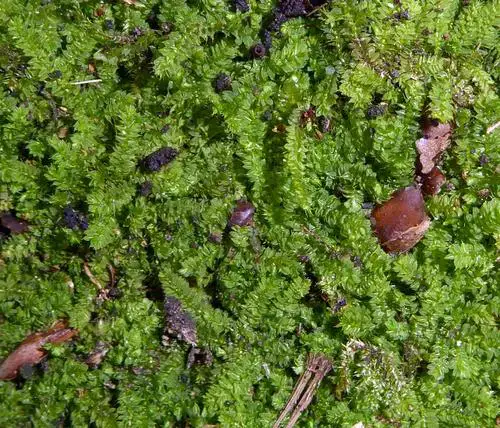
34747336.jpg from: https://waarneming.nl/waarneming/view/207468857?_popup=1
Exploring the Fascinating World of Brachythecium Velutinum Moss
Introduction
Have you ever noticed the velvety green carpet covering rocks, tree trunks, or soil in forests? There’s a good chance you were looking at Brachythecium velutinum

Brachytheciastrum_velutinum_8c.JPG from: https://cisfbr.org.uk/Bryo/Cornish_Bryophytes_Brachytheciastrum_velutinum.html
, a captivating moss species. In this blog post, we’ll dive into the intriguing world of this Brachytheciaceae family member and discover what makes it so special.
Background on Brachythecium Velutinum
Brachythecium velutinum (Hedw.) Schimp., commonly known as velvet feather moss, is a pleurocarpous moss species belonging to the Brachytheciaceae family. It is classified under the Bryophyta division and Bryopsida class. This moss is widely distributed across Europe, Asia, and North America.
Morphology and Identification
B. velutinum forms dense mats with a soft, velvety texture. The stems are creeping and irregularly branched, reaching lengths of up to 10 cm. The leaves are ovate-lanceolate,

491070_1d294258.jpg from: https://www.plantarium.ru/page/image/id/491070.html
concave, and have a single costa extending to the leaf tip. They are typically 1.5-2.5 mm long and 0.6-1 mm wide. The leaf margins are serrate and the leaf cells are elongated and prosenchymatous.
The sporophytes of B. velutinum are frequent. The setae are smooth

Brachythecium-veutinum-AH-3.jpg from: https://sites.cortland.edu/bryophytes/field-guide/mosses/pleurocarp/brachythecium-velutinum/
, reddish-brown, and 1.5-3 cm long. Capsules are inclined to horizontal, cylindrical, and curved, with a conical operculum.

medium.jpg from: https://www.inaturalist.org/taxa/154134-Brachythecium-velutinum

824048.jpg from: https://www.bio-forum.pl/messages/3280/824044.html

49867729932_0302094e05_b.jpg from: https://www.flickr.com/photos/21657471@N04/49867729932/
| Characteristic | Description |
|---|---|
| Stem | Creeping, irregularly branched, up to 10 cm long |
| Leaves | Ovate-lanceolate, concave, single costa, 1.5-2.5 mm long, 0.6-1 mm wide |
| Leaf margins | Serrate |
| Leaf cells | Elongated, prosenchymatous |
| Sporophytes | Frequent |
| Setae | Smooth, reddish-brown, 1.5-3 cm long |
| Capsules | Inclined to horizontal, cylindrical, curved, with conical operculum |
Global Distribution and Habitat
B. velutinum is widely distributed across the Northern Hemisphere

brachythecium_rutabulum_01_gb.jpg from: https://cbnfc-ori.org/fiche-espece/especes-vegetales/1318b/13754
, including Europe, Asia, and North America. It grows on various substrates such as soil, rocks, tree trunks, and decaying wood in forests, woodlands, and urban areas. This moss prefers shaded and moist habitats.
Ecological Roles and Adaptations
B. velutinum plays important ecological roles:
- It helps

49832234963_04c3d066d1_b.jpg from: https://www.flickr.com/photos/silybum/49832234963
retain moisture in the soil and prevents erosion.
- It provides shelter and microhabitats for small invertebrates.
- It contributes to nutrient cycling by trapping and releasing nutrients.
This moss has adapted to its environment in several ways:
- The velvety texture helps capture and retain water.
- The dense growth form protects against desiccation.
- The elongated leaf cells facilitate water conduction.
Conclusion
Brachythecium velutinum is a fascinating moss species with a wide distribution and important ecological roles. Its velvety appearance and adaptations make it well-suited for the shaded, moist habitats it calls home. Next time you’re out in nature, keep an eye out for this captivating little plant. Who knows what other secrets it holds?

51673266314_f944f2ee22_b.jpg from: https://www.flickr.com/photos/21657471@N04/51673266314/